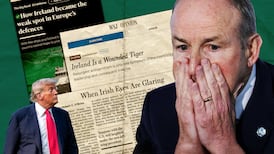On Tuesday, as the DUP began retreating from a Stormont deal, it was forced to deny a split between its MPs and assembly members.
"There is no power struggle between Westminster and Stormont. But individuals in both groups have raised key issues," a party source told the Belfast Telegraph.
Later that day, DUP leader Arlene Foster put on a show of unity for the cameras, conspicuously flanked by a variety of colleagues.
There is rarely this much focus on the DUP’s internal machinations, in contrast with the Kremlinology devoted to Sinn Féin.
Ironically, Sinn Féin is largely responsible for the idea of a DUP divide.
After last June’s Tory-unionist pact at Westminster, Sinn Féin began pushing a tale of hardline DUP MPs seizing the initiative from relatively moderate DUP assembly members – including Foster.
There are enough apparent differences between the DUP's Westminster and Stormont groups for the notion of a split to have caught hold
This story served an ideological purpose for Sinn Féin, explaining why republicans still wanted a Stormont partnership with the DUP despite the DUP being in an unacceptable arrangement with the Tories.
It also felt like a riposte to unionist criticism of the republican movement, in which a hardline IRA army council is said to be keeping relatively moderate Sinn Féin away from devolution.
There are enough apparent differences between the DUP’s Westminster and Stormont groups for the notion of a split to have caught hold. However, this impression is so simplistic as to be completely misleading.
A range of views exist across both camps, with people in each who are inclined to stand outside the tent – encouraged by a party legacy of individual power bases. Rather than a dichotomous organisation like Sinn Féin and the IRA, it is more accurate to think of the DUP as a Fianna Fáil of Healy-Raes, although few would ever dare go independent.
Double jobbing
The tradition of power bases benefited greatly from double jobbing, the practice of holding multiple elected offices, with numerous DUP representatives serving as councillors, assembly members and MPs at the same time.
Double jobbing was outlawed in phases over the past decade – a dubious intrusion on democracy, as voters had endorsed it.
For the political establishment, the appeal of ending double jobbing was that it shifted power and patronage to party leaderships. When this happened to the DUP, some big names were forced to choose between Stormont and Westminster and their independence diminished.
The result is a cadre of characters who feel semi-retired and whose eccentricities the party tends to tolerate. The media loves them, understandably, because they are outspoken and available – creating a distorting effect on perceptions of the DUP and Northern Ireland politics in general.
Paisley has since flipped back to hardline positions and teasing of republicans, suggesting all he stands for is himself
While no new power bases are likely to be built, some serious ones remain. Nigel Dodds is DUP deputy leader and leader in the Commons. His wife Diane is an MEP. Dodds was offered the party leadership before Foster's anointment but turned it down, as he is genuinely more interested in Westminster and feels the DUP must be led from Stormont.
This makes his relationship with Foster unusual, as disagreements between them are not driven by much rivalry. Republicans who imagine Foster pitted against Dodds are like unionists who hoped for rows between Gerry Adams and Martin McGuinness.
Ian Paisley jnr MP has a deceptive prominence – the public assumes his surname makes him hugely influential, while the party regards him as a lone wolf.
Hardline positions
In January last year, shortly after McGuinness resigned as deputy first minister, Paisley paid tribute to the Sinn Féin man for the kindness he had shown to his father. The public was moved by Paisley’s words but he was also clearly rebuking Foster for mishandling Sinn Féin at Stormont. Paisley has since flipped back to hardline positions and teasing of republicans, suggesting all he stands for is himself.
Another interesting case is David Simpson MP – hardline, low-profile and independently wealthy. His money insulates him from the leadership but the leadership seems to have insulated itself from him.
At Stormont, independent power bases have drawn heavily on the DUP's Free Presbyterian roots. An attempt to keep this together after Ian Paisley snr's retirement was its undoing. In 2012, a creationist exhibit at the Giant's Causeway visitors centre exposed the influence of the Caleb Foundation, an evangelical pressure group within the DUP. Leading Caleb members, who included MLAs, MPs and Stormont ministers, endured nationwide ridicule.
They stumbled on, mounting a coup in 2014 against Foster's predecessor Peter Robinson, which he swiftly beheaded by sacking its leader, Edwin Poots, from the executive. Long-standing tensions between religious and relatively secular wings of the DUP have since abated – Foster, who is no Bible thumper, would have struggled to become leader otherwise, while Poots has recently advocated reconciliation with Sinn Féin.
Take a closer look at the cracks within the DUP and the question is not whether it is going to split, but why a party this united is still so afraid of taking risks.










